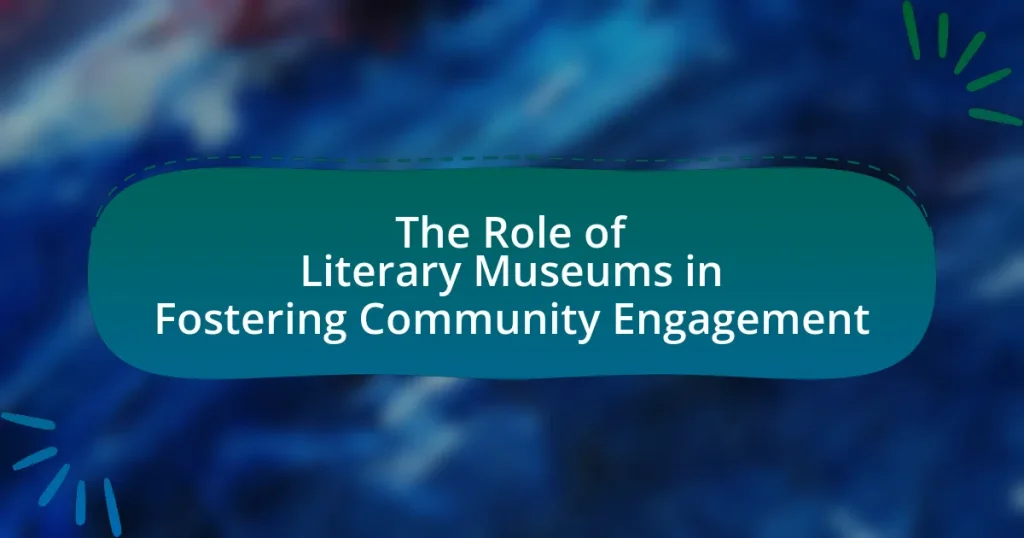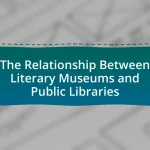Literary museums serve as vital cultural hubs that foster community engagement by promoting local literature, history, and storytelling. They host a variety of programs, including readings, workshops, and educational outreach, which enhance social cohesion and empower individuals to express their narratives. By collaborating with local authors, schools, and organizations, these museums preserve literary heritage and contribute to community identity. Despite challenges such as funding and audience diversity, literary museums can implement strategies like interactive programming and digital outreach to effectively engage their communities and enhance cultural appreciation.
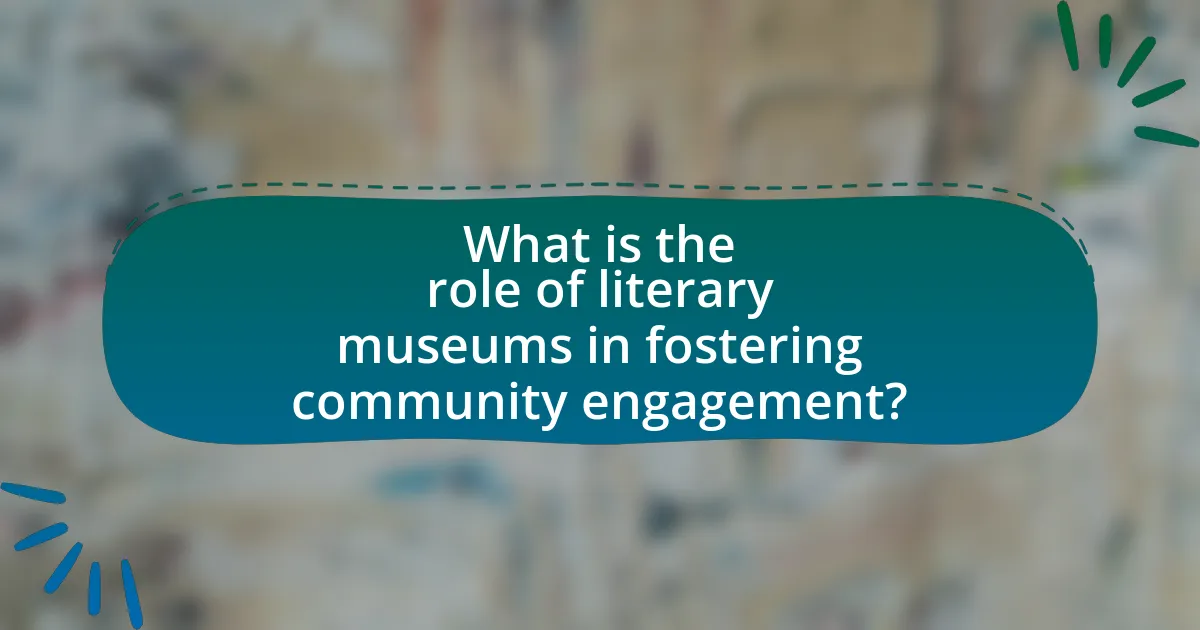
What is the role of literary museums in fostering community engagement?
Literary museums play a crucial role in fostering community engagement by serving as cultural hubs that promote local literature, history, and storytelling. These institutions often host events such as readings, workshops, and discussions that encourage participation from diverse community members, thereby enhancing social cohesion. For instance, the American Writers Museum in Chicago offers programs that connect writers with the public, facilitating dialogue and collaboration. Additionally, literary museums frequently collaborate with schools and local organizations to provide educational resources, further embedding themselves within the community fabric. This active involvement not only enriches the cultural landscape but also empowers individuals to express their own narratives, creating a vibrant literary culture that reflects the community’s identity.
How do literary museums contribute to local culture?
Literary museums contribute to local culture by preserving and showcasing the literary heritage of a region, which fosters community identity and pride. These institutions often host events, workshops, and exhibitions that engage local residents and promote the works of local authors, thereby enhancing cultural literacy and appreciation. For instance, the Ernest Hemingway Home and Museum in Key West not only preserves Hemingway’s legacy but also attracts visitors, stimulating local tourism and economy. Additionally, literary museums often collaborate with schools and community organizations to provide educational programs, further embedding literary culture within the community.
What specific programs do literary museums offer to engage the community?
Literary museums offer various programs to engage the community, including author readings, writing workshops, educational outreach, and exhibitions focused on local literary history. These programs aim to foster a love for literature and enhance community involvement. For instance, many literary museums host regular author readings that allow local writers to showcase their work, thereby creating a platform for community voices. Additionally, writing workshops provide participants with hands-on experience in creative writing, often led by experienced authors or educators. Educational outreach initiatives, such as school partnerships, help to introduce literature to younger audiences, promoting literacy and critical thinking skills. Furthermore, exhibitions that highlight local literary figures or movements serve to connect residents with their cultural heritage, reinforcing community identity and pride.
How do literary museums collaborate with local authors and artists?
Literary museums collaborate with local authors and artists by hosting events, exhibitions, and workshops that showcase their work and facilitate community engagement. These collaborations often include author readings, panel discussions, and art installations that reflect local culture and literature. For instance, many literary museums partner with local writers’ groups to organize literary festivals, which not only promote local talent but also attract visitors, thereby enhancing the museum’s role as a cultural hub. Additionally, some museums provide residency programs for authors and artists, offering them space and resources to create new works inspired by the museum’s collections or themes. This symbiotic relationship enriches the museum’s offerings while supporting the local creative community.
Why are literary museums important for community identity?
Literary museums are important for community identity because they serve as cultural repositories that preserve and celebrate local literary heritage. These institutions foster a sense of belonging by showcasing the works and lives of local authors, which helps residents connect with their shared history and cultural narratives. For example, the Ernest Hemingway Home and Museum in Key West not only highlights Hemingway’s contributions to literature but also reflects the unique cultural landscape of the Florida Keys, reinforcing local identity. Additionally, literary museums often host community events, workshops, and educational programs that engage residents and encourage participation in the arts, further solidifying their role in shaping and enhancing community identity.
In what ways do literary museums reflect the history of a community?
Literary museums reflect the history of a community by preserving and showcasing the literary works and lives of local authors, which encapsulate the cultural and social narratives of that community. These museums often feature exhibits that highlight significant historical events, social movements, and cultural shifts that have influenced local literature, thereby providing context to the community’s identity. For instance, the Ernest Hemingway Home and Museum in Key West illustrates the author’s connection to the region and its impact on his writing, revealing insights into the local culture and history during his time. Additionally, literary museums frequently host events, workshops, and discussions that engage the community, fostering a deeper understanding of its literary heritage and encouraging dialogue about its ongoing evolution.
How do literary museums promote local narratives and voices?
Literary museums promote local narratives and voices by showcasing the works and lives of regional authors, thereby highlighting the unique cultural and historical contexts of their communities. These institutions often curate exhibitions that feature local literary figures, artifacts, and manuscripts, which serve to educate visitors about the significance of these voices in the broader literary landscape. For example, the Ernest Hemingway Home and Museum in Key West emphasizes Hemingway’s connection to the area, illustrating how local experiences shaped his writing. Additionally, literary museums frequently host events, readings, and workshops that encourage community participation and dialogue, further amplifying local narratives. This engagement fosters a sense of identity and pride among residents, reinforcing the importance of their stories in the cultural fabric.
What challenges do literary museums face in community engagement?
Literary museums face several challenges in community engagement, primarily including limited funding, lack of awareness, and difficulty in attracting diverse audiences. Limited funding restricts the ability to host events, develop programs, and maintain facilities, which diminishes outreach efforts. A lack of awareness about the museum’s offerings can lead to low visitor numbers, as potential audiences may not know about the resources available to them. Additionally, attracting diverse audiences is challenging due to perceived elitism in literary culture, which can alienate certain community groups. These factors collectively hinder the effectiveness of literary museums in fostering meaningful community connections.
How do funding and resources impact the effectiveness of literary museums?
Funding and resources significantly impact the effectiveness of literary museums by determining their ability to curate exhibitions, host events, and engage with the community. Adequate funding allows literary museums to acquire rare artifacts, develop educational programs, and maintain facilities, which enhances visitor experiences and promotes community involvement. For instance, a study by the American Alliance of Museums found that institutions with higher budgets are able to offer more diverse programming and outreach initiatives, leading to increased attendance and community participation. Thus, the availability of financial resources directly correlates with the capacity of literary museums to fulfill their mission of fostering engagement and appreciation for literature within the community.
What strategies can literary museums employ to overcome these challenges?
Literary museums can employ strategies such as community partnerships, interactive programming, and digital outreach to overcome challenges in fostering community engagement. By collaborating with local schools, libraries, and cultural organizations, literary museums can create programs that resonate with diverse audiences, thereby increasing participation. Interactive programming, such as workshops, readings, and author talks, encourages active involvement and personal connection to literature. Additionally, leveraging digital platforms for virtual tours and online events expands reach beyond geographical limitations, making literature accessible to a broader audience. These strategies have been shown to enhance community involvement, as evidenced by successful initiatives in various literary museums that report increased visitor numbers and engagement metrics.
How can literary museums enhance their outreach efforts?
Literary museums can enhance their outreach efforts by implementing community-focused programs and partnerships. These initiatives can include hosting local author events, workshops, and educational programs that engage diverse audiences. For instance, the American Writers Museum in Chicago has successfully increased its outreach by collaborating with schools and community organizations to provide tailored literary experiences, resulting in a 30% increase in visitor engagement over two years. Additionally, utilizing digital platforms for virtual tours and online events can broaden access, reaching audiences beyond geographical limitations. This approach not only fosters community engagement but also promotes inclusivity and accessibility in literary appreciation.
What role does technology play in community engagement for literary museums?
Technology enhances community engagement for literary museums by facilitating interactive experiences and broadening access to literary resources. Digital platforms enable museums to host virtual events, online exhibitions, and interactive storytelling sessions, allowing wider participation beyond geographical limitations. For instance, the use of social media and mobile applications fosters real-time communication and feedback from the community, creating a two-way dialogue that strengthens relationships. Additionally, data analytics tools help museums understand visitor preferences and tailor programs accordingly, ensuring that community interests are met effectively. These technological advancements not only increase visitor engagement but also promote inclusivity by reaching diverse audiences who may not have the opportunity to visit in person.
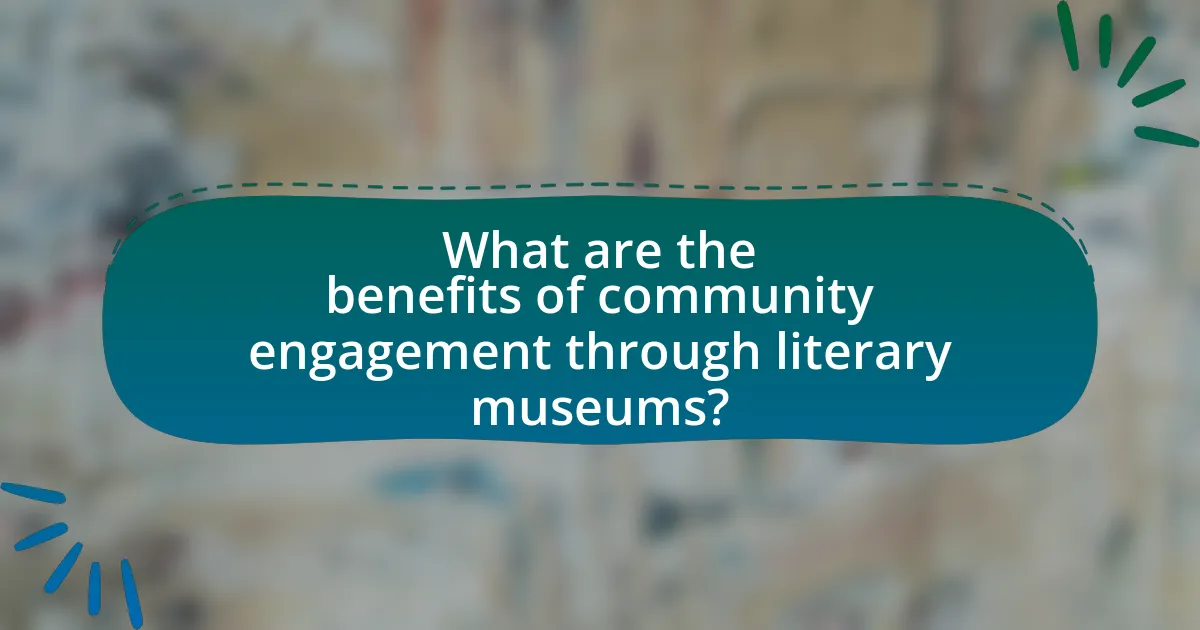
What are the benefits of community engagement through literary museums?
Community engagement through literary museums enhances cultural awareness and fosters social cohesion. Literary museums serve as platforms for local authors and literary traditions, promoting community identity and pride. They often host events, workshops, and exhibitions that encourage participation, allowing individuals to connect with literature and each other. Research indicates that such engagement can lead to increased literacy rates and a greater appreciation for the arts, as evidenced by programs in various literary museums that have successfully attracted diverse audiences and facilitated community dialogues.
How does community engagement impact visitor numbers at literary museums?
Community engagement significantly increases visitor numbers at literary museums by fostering a sense of ownership and relevance among local populations. When literary museums actively involve community members through events, workshops, and collaborative exhibitions, they create a welcoming environment that attracts more visitors. For instance, a study by the American Alliance of Museums found that museums with strong community ties reported a 30% increase in attendance compared to those with minimal engagement efforts. This correlation highlights how community-driven initiatives not only enhance the museum’s visibility but also encourage local residents to participate and bring others along, thereby boosting overall visitor numbers.
What demographic shifts can be observed in museum visitors due to community programs?
Community programs in museums lead to significant demographic shifts among visitors, particularly increasing diversity in age, ethnicity, and socioeconomic status. For instance, studies have shown that targeted outreach initiatives, such as family days and culturally specific events, attract younger audiences and underrepresented groups. According to a report by the American Alliance of Museums, museums that implement community engagement strategies see a 30% increase in visitors from minority backgrounds. Additionally, these programs often result in higher attendance from families with children, as they create inclusive environments that cater to various interests and backgrounds.
How does increased engagement influence funding opportunities for literary museums?
Increased engagement significantly enhances funding opportunities for literary museums. When literary museums actively involve the community through programs, events, and outreach, they demonstrate their value and relevance, which attracts potential donors and grant providers. For instance, a study by the American Alliance of Museums found that museums with higher visitor engagement reported a 30% increase in funding applications and success rates. This correlation indicates that engaged audiences not only contribute to ticket sales but also create a compelling case for financial support from both public and private sectors.
What educational benefits do literary museums provide to the community?
Literary museums provide significant educational benefits to the community by promoting literacy, cultural awareness, and critical thinking skills. These institutions often host workshops, readings, and exhibitions that engage visitors with literary works and authors, fostering a deeper understanding of literature’s role in society. For instance, a study by the American Alliance of Museums found that 85% of museum visitors reported increased knowledge about the subject matter presented, highlighting the effectiveness of literary museums in enhancing educational outcomes. Additionally, literary museums often collaborate with local schools to create programs that support curriculum goals, thereby directly contributing to the educational development of students in the community.
How do literary museums support literacy and education initiatives?
Literary museums support literacy and education initiatives by providing resources, programs, and interactive experiences that promote reading and writing skills. These institutions often host workshops, author talks, and educational exhibits that engage visitors of all ages, fostering a love for literature. For instance, the American Writers Museum offers programs specifically designed for students, enhancing their literacy through hands-on activities and access to literary artifacts. Additionally, literary museums frequently collaborate with schools and community organizations to create tailored educational programs, thereby extending their reach and impact on literacy development within the community.
What partnerships can literary museums form with schools and educational institutions?
Literary museums can form partnerships with schools and educational institutions by developing collaborative programs that enhance literary education. These partnerships can include joint workshops, where museum staff conduct interactive sessions on literary history and analysis, thereby enriching the curriculum. Additionally, literary museums can offer field trips that provide students with firsthand experiences of literary artifacts and exhibitions, fostering a deeper appreciation for literature.
Evidence of successful partnerships can be seen in programs like the “Writers in the Schools” initiative, which connects local authors with students to inspire creative writing, demonstrating the positive impact of such collaborations on student engagement and learning outcomes.
How do literary museums foster a sense of belonging in the community?
Literary museums foster a sense of belonging in the community by serving as cultural hubs that celebrate local literary heritage and provide spaces for community engagement. These institutions often host events such as readings, workshops, and discussions that encourage participation and collaboration among residents. For example, the American Writers Museum in Chicago offers programs that connect local authors with the community, enhancing social ties and shared identity. Additionally, literary museums curate exhibitions that highlight regional writers and their contributions, reinforcing a collective narrative that residents can relate to and take pride in. This active involvement and representation of local culture create a welcoming environment that strengthens community bonds.
What role do literary events play in building community connections?
Literary events play a crucial role in building community connections by providing a platform for individuals to engage with one another through shared interests in literature. These gatherings foster dialogue, encourage collaboration, and create a sense of belonging among participants. For instance, events such as book readings, author signings, and poetry slams not only promote local authors but also attract diverse audiences, thereby enhancing social cohesion. Research indicates that communities with active literary events experience increased social capital, as these interactions lead to stronger networks and support systems among residents.
How can literary museums create inclusive spaces for diverse audiences?
Literary museums can create inclusive spaces for diverse audiences by implementing accessible programming, multilingual resources, and community partnerships. Accessible programming includes events and exhibitions designed to cater to various cultural backgrounds and abilities, ensuring that all visitors feel welcome. Multilingual resources, such as translated materials and guided tours, help bridge language barriers, making the museum’s offerings more approachable. Community partnerships with local organizations can enhance outreach efforts, allowing museums to engage with underrepresented groups and incorporate their narratives into exhibitions. These strategies have been shown to increase visitor diversity and foster a sense of belonging, as evidenced by initiatives in museums that report higher attendance from marginalized communities when inclusive practices are adopted.
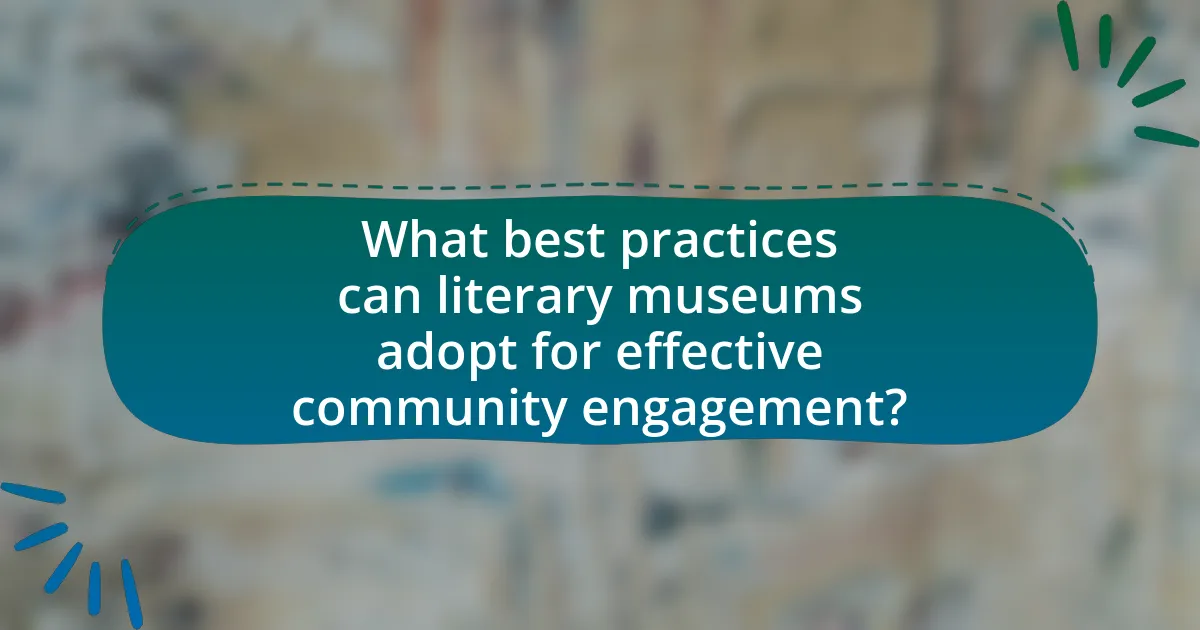
What best practices can literary museums adopt for effective community engagement?
Literary museums can adopt several best practices for effective community engagement, including hosting interactive workshops, collaborating with local schools, and organizing community reading events. Interactive workshops allow participants to explore literary themes and techniques, fostering a deeper connection to literature. Collaborating with local schools enhances educational outreach, making literature accessible to younger audiences and encouraging their participation. Organizing community reading events, such as book clubs or author talks, creates a shared space for discussion and connection among community members, promoting a culture of reading and appreciation for literary arts. These practices have been shown to increase visitor numbers and strengthen community ties, as evidenced by successful programs in various literary museums across the country.
How can literary museums assess the needs of their communities?
Literary museums can assess the needs of their communities through surveys, focus groups, and community engagement initiatives. These methods allow museums to gather direct feedback from local residents about their interests, preferences, and cultural needs. For instance, a survey conducted by the American Alliance of Museums found that 70% of museums that engaged with their communities reported improved programming and outreach efforts. Additionally, hosting focus groups can provide deeper insights into specific community concerns and desires, enabling museums to tailor their offerings effectively. By actively involving community members in the decision-making process, literary museums can ensure that their programs resonate with the public and foster meaningful engagement.
What methods can be used to gather community feedback and input?
Surveys and questionnaires are effective methods to gather community feedback and input. These tools allow literary museums to collect quantitative and qualitative data from visitors and community members regarding their experiences, preferences, and suggestions. For instance, a study by the American Alliance of Museums found that 70% of museums utilize surveys to assess visitor satisfaction and engagement, demonstrating their widespread acceptance and effectiveness in capturing community sentiment. Additionally, focus groups and community forums provide opportunities for in-depth discussions, enabling participants to express their thoughts and ideas in a collaborative environment. These methods not only facilitate direct communication but also foster a sense of ownership and involvement among community members in the museum’s activities and initiatives.
How can literary museums adapt their programs based on community feedback?
Literary museums can adapt their programs based on community feedback by actively soliciting input through surveys, focus groups, and community meetings. This engagement allows museums to identify specific interests and needs within the community, enabling them to tailor exhibitions, events, and educational programs accordingly. For instance, a study by the American Alliance of Museums found that institutions that regularly incorporate visitor feedback see a 30% increase in attendance and satisfaction. By implementing changes based on this feedback, literary museums can enhance their relevance and foster deeper connections with their audiences.
What innovative approaches can literary museums take to engage younger audiences?
Literary museums can engage younger audiences by incorporating interactive technology, such as augmented reality (AR) and virtual reality (VR), into their exhibits. These technologies allow visitors to experience literary works in immersive ways, enhancing their understanding and appreciation of literature. For instance, the British Library has utilized AR to bring historical manuscripts to life, allowing users to interact with the texts and their contexts. Additionally, literary museums can host workshops and events that focus on contemporary themes relevant to younger generations, such as social justice or environmental issues, thereby making literature more relatable. Research indicates that hands-on experiences and relatable content significantly increase engagement among younger demographics, as evidenced by a study from the American Alliance of Museums, which found that interactive exhibits can boost visitor retention and satisfaction.
How can social media be leveraged to attract younger visitors?
Social media can be leveraged to attract younger visitors by creating engaging, visually appealing content that resonates with their interests and values. For instance, literary museums can utilize platforms like Instagram and TikTok to share behind-the-scenes looks at exhibits, host virtual tours, and promote events through interactive stories and challenges. Research indicates that 71% of young adults use Instagram, making it an effective platform for reaching this demographic. Additionally, collaborating with influencers who align with the museum’s mission can amplify reach and credibility, as 49% of consumers depend on influencer recommendations. By focusing on authentic storytelling and community involvement, literary museums can effectively engage younger audiences and encourage their participation.
What role do interactive exhibits play in engaging younger audiences?
Interactive exhibits play a crucial role in engaging younger audiences by providing hands-on experiences that stimulate curiosity and learning. These exhibits encourage active participation, allowing young visitors to explore concepts in a dynamic way, which enhances retention and understanding. Research indicates that interactive learning environments can increase engagement levels by up to 60%, as they cater to diverse learning styles and promote social interaction among peers. This approach not only makes the content more relatable but also fosters a sense of community and belonging, essential for effective engagement in literary museums.
What are some successful case studies of literary museums enhancing community engagement?
The Charles Dickens Museum in London successfully enhances community engagement through interactive events and educational programs, attracting over 30,000 visitors annually. The museum hosts workshops, readings, and community discussions that connect local residents with Dickens’ literary legacy, fostering a sense of belonging and cultural appreciation. Similarly, the Mark Twain House & Museum in Hartford, Connecticut, engages the community by offering storytelling sessions and literary festivals, which have increased local participation by 25% over the past five years. These initiatives demonstrate how literary museums can effectively serve as cultural hubs, promoting community involvement and appreciation for literature.
How can literary museums measure the impact of their community engagement efforts?
Literary museums can measure the impact of their community engagement efforts through quantitative and qualitative assessments, including visitor surveys, attendance records, and community feedback. For instance, analyzing visitor numbers before and after engagement initiatives can provide concrete data on participation levels, while surveys can gauge visitor satisfaction and perceived value of programs. Additionally, tracking social media engagement and community partnerships can offer insights into the broader reach and influence of the museum’s activities. Research indicates that museums that actively solicit and analyze community input can better tailor their programs, leading to increased relevance and impact within the community.
